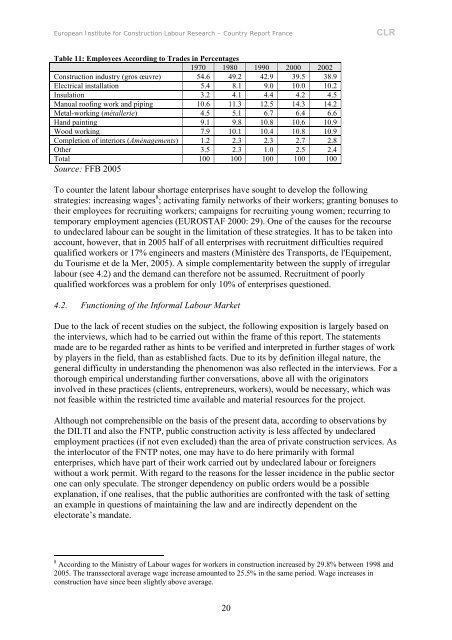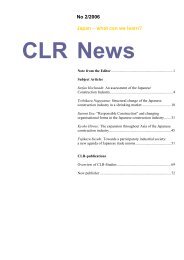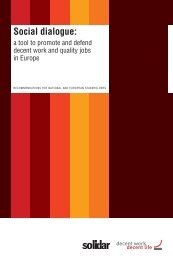Country report France - Construction Labour Research
Country report France - Construction Labour Research
Country report France - Construction Labour Research
You also want an ePaper? Increase the reach of your titles
YUMPU automatically turns print PDFs into web optimized ePapers that Google loves.
European Institute for <strong>Construction</strong> <strong>Labour</strong> <strong>Research</strong> – <strong>Country</strong> Report <strong>France</strong>CLRTable 11: Employees According to Trades in Percentages1970 1980 1990 2000 2002<strong>Construction</strong> industry (gros œuvre) 54.6 49.2 42.9 39.5 38.9Electrical installation 5.4 8.1 9.0 10.0 10.2Insulation 3.2 4.1 4.4 4.2 4.5Manual roofing work and piping 10.6 11.3 12.5 14.3 14.2Metal-working (métallerie) 4.5 5.1 6.7 6.4 6.6Hand painting 9.1 9.8 10.8 10.6 10.9Wood working 7.9 10.1 10.4 10.8 10.9Completion of interiors (Aménagements) 1.2 2.3 2.3 2.7 2.8Other 3.5 2.3 1.0 2.5 2.4Total 100 100 100 100 100Source: FFB 2005To counter the latent labour shortage enterprises have sought to develop the followingstrategies: increasing wages 8 ; activating family networks of their workers; granting bonuses totheir employees for recruiting workers; campaigns for recruiting young women; recurring totemporary employment agencies (EUROSTAF 2000: 29). One of the causes for the recourseto undeclared labour can be sought in the limitation of these strategies. It has to be taken intoaccount, however, that in 2005 half of all enterprises with recruitment difficulties requiredqualified workers or 17% engineers and masters (Ministère des Transports, de l'Equipement,du Tourisme et de la Mer, 2005). A simple complementarity between the supply of irregularlabour (see 4.2) and the demand can therefore not be assumed. Recruitment of poorlyqualified workforces was a problem for only 10% of enterprises questioned.4.2. Functioning of the Informal <strong>Labour</strong> MarketDue to the lack of recent studies on the subject, the following exposition is largely based onthe interviews, which had to be carried out within the frame of this <strong>report</strong>. The statementsmade are to be regarded rather as hints to be verified and interpreted in further stages of workby players in the field, than as established facts. Due to its by definition illegal nature, thegeneral difficulty in understanding the phenomenon was also reflected in the interviews. For athorough empirical understanding further conversations, above all with the originatorsinvolved in these practices (clients, entrepreneurs, workers), would be necessary, which wasnot feasible within the restricted time available and material resources for the project.Although not comprehensible on the basis of the present data, according to observations bythe DILTI and also the FNTP, public construction activity is less affected by undeclaredemployment practices (if not even excluded) than the area of private construction services. Asthe interlocutor of the FNTP notes, one may have to do here primarily with formalenterprises, which have part of their work carried out by undeclared labour or foreignerswithout a work permit. With regard to the reasons for the lesser incidence in the public sectorone can only speculate. The stronger dependency on public orders would be a possibleexplanation, if one realises, that the public authorities are confronted with the task of settingan example in questions of maintaining the law and are indirectly dependent on theelectorate’s mandate.8 According to the Ministry of <strong>Labour</strong> wages for workers in construction increased by 29.8% between 1998 and2005. The transsectoral average wage increase amounted to 25.5% in the same period. Wage increases inconstruction have since been slightly above average.20









